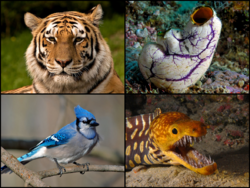Biology:Olfactores
| Olfactores | |
|---|---|

| |
| Example of Olfactores | |
| Scientific classification | |
| Domain: | Eukaryota |
| Kingdom: | Animalia |
| Subkingdom: | Eumetazoa |
| Clade: | ParaHoxozoa |
| Clade: | Bilateria |
| Clade: | Nephrozoa |
| Superphylum: | Deuterostomia |
| Phylum: | Chordata |
| Clade: | Olfactores Jefferies, 1991 |
| Subgroups | |
Olfactores is a clade within the Chordata that comprises the Tunicata (Urochordata) and the Vertebrata (sometimes referred to as Craniata). Olfactores represent the overwhelming majority of the phylum Chordata, as the Cephalochordata are the only chordates not included in the clade. This clade is defined by a more advanced olfactory system which, in the immediate vertebrate generation, caused the appearance of nostrils.
A rudimentary neural crest is present in tunicates, implying its presence in the olfactores ancestor also, as vertebrates have a true neural crest.[3] For this reason, they are also known as Cristozoa.[clarification needed]
Olfactores hypothesis
While the hypothesis that Cephalochordata is a sister taxon to Craniata is of long standing and was once widely accepted[4]—likely influenced by significant tunicate morphological apomorphies from other chordates, with cephalochordates even being nicknamed ‘honorary vertebrates’[5]—studies since 2006 analyzing large sequencing datasets strongly support Olfactores as a clade.[6][7] The name Olfactores comes from Latin *olfactores ("smellers," from purposive supine olfactum of olfacio, "to smell," with plural masculine agentive nominalizing suffix -tores), due to the development of pharyngeal respiratory and sensory functions, in contrast with cephalochordates such as the lancelet which lack a respiratory system and specialized sense organs.[8]
References
- ↑ Yang, Chuan; Li, Xian-Hua; Zhu, Maoyan; Condon, Daniel J.; Chen, Junyuan (2018). "Geochronological constraint on the Cambrian Chengjiang biota, South China" (in en). Journal of the Geological Society 175 (4): 659–666. doi:10.1144/jgs2017-103. ISSN 0016-7649. Bibcode: 2018JGSoc.175..659Y. http://nora.nerc.ac.uk/id/eprint/521412/1/2018-JGS-Chuan%20Yang%20et%20al.pdf.
- ↑ Fedonkin, M. A.; Vickers-Rich, P.; Swalla, B. J.; Trusler, P.; Hall, M. (2012). "A new metazoan from the Vendian of the White Sea, Russia, with possible affinities to the ascidians". Paleontological Journal 46: 1–11. doi:10.1134/S0031030112010042.
- ↑ York, Joshua R.; McCauley, David W. (2020). "The origin and evolution of vertebrate neural crest cells". Open Biology 10 (1): 190285. doi:10.1098/rsob.190285. PMID 31992146.
- ↑ Stach, Thomas (2008). "Chordate phylogeny and evolution: a not so simple three‐taxon problem". Journal of Zoology 276 (2): 117–141. doi:10.1111/j.1469-7998.2008.00497.x.
- ↑ Ax, P (2001). Das System der Metazoa: ein Lehrbuch der phylogenetischen Systematik.
- ↑ Delsuc, F (2006). "Tunicates and not cephalochordates are the closest living relatives of vertebrates.". Nature 439 (7079): 965–968. doi:10.1038/nature04336. PMID 16495997. Bibcode: 2006Natur.439..965D. https://hal.archives-ouvertes.fr/halsde-00315436/file/Delsuc-Nature06_HAL.pdf.
- ↑ Dunn, C.W. (2008). "Broad phylogenetic sampling improves resolution of the animal tree of life.". Nature 452 (7188): 745–749. doi:10.1038/nature06614. PMID 18322464. Bibcode: 2008Natur.452..745D.
- ↑ Benton, M.J. (14 April 2000). Vertebrate Palaeontology: Biology and Evolution. Blackwell Publishing.
Wikidata ☰ Q3280581 entry
 |

